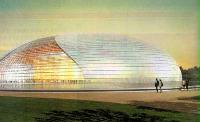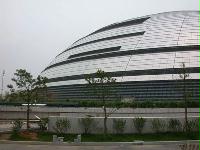Construction work on Beijing's National Grand Theater is
expected to be completed by the end of next year, with its first
show opening in 2006, officials announced on Monday.

December 13 marks the third
anniversary since the US$325 million project broke ground.
"After completion next year, we will commission sophisticated
music facilities in the theater's three major buildings," said an
official from the Project Proprietors' Committee.
"The commissioning will last several months, as musical
instruments such as the pipe organ require a clean, dustless
environment," acknowledged the official.
The committee noted that many top performing companies at home
and abroad have been consulted on its performing procedures.
Competition for the first show is especially fierce. The
theater's art director said months earlier that it had received 21
proposals, some of which were from overseas, including from the
British Royal Opera. But a final decision hasn't yet been made.
Situated near Tian'anmen Square and behind the magnificent Great
Hall of the People, the theater is an enormous glass and titanium
tear-drop-like bubble surrounded by water.

It occupies an area of some
149,520 square meters (1.6 million sq feet) and comprises three
gigantic halls: a 2,416-seat opera house, a 2,017-seat concert hall
and a 1,040-seat theater.
Three questions have dogged its construction: who is to manage
it after completion, should it be run as a commercial organization
or be public service-oriented, and what should be done about its
bulky financial deficit?
The latter issue has worsened amid much media speculation; days
ago Wang Zhengming, Party secretary to the Project Proprietors'
Committee, testified that the deficit is estimated to be about 200
million yuan (US$ 24 million).
But he said the theater's budget reflects wider economic changes
since 1998, as prices for construction materials such as steel,
cement and sand have all risen sharply. Transport costs have also
climbed due to regulations recently adopted by the municipal
government.
Exchange rates have also played a part, especially that between
the euro and US dollar. "Many of the musical instruments and
facilities are bought from European countries. But they were
budgeted in US dollars. As the euro has risen against the US
dollar, it has added to our deficit," explained Wang.
As the time for its completion and debut approaches, the Grand
Theater faces new challenges.
The first comes from unforeseen problems with its design. The
unique egg-shape will produce a huge amount of light pollution for
surrounding areas by refracting and reflecting sunlight, something
that has only recently been realized.
The second headache is around pricing. The initial aim was to
increase access for ordinary people to the performing arts, but if
prices need to be increased to cover higher costs the original
intention is lost.

"In Beijing, Shanghai and
Guangzhou the expense of enjoying live artistic performances is
already high enough. Frankly, I couldn't afford it if I had to pay
for all the concerts I have attended," says Wu Zuqiang, member of
the Standing Committee of the Chinese People's Political
Consultative Conference (CPPCC) and director of the Art Committee
of the Grand Theater.
As the country's most prestigious performance venue, and one
built and run according to the highest international standards,
operating costs will be enormous. One conventional practice in
Chinese cultural circles will also make the problem even worse:
offering gift tickets for free.
(China.org.cn by Wind Gu, December 15, 2004)